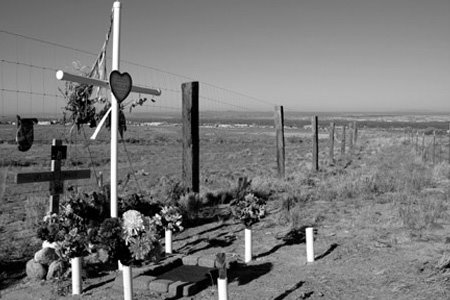
The New York Times recently had an article on the proliferation of roadside memorials, which indeed seem to dot — if not now, then soon will be — each and every mile of America's highways and byways.
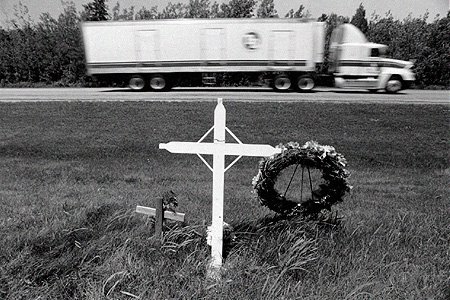
Usually DIY affairs crafted out of crosses, balloons, teddy bears, flowers and Ziplocked photos but now can also be purchased commercially from online sources such as roadsidememorials.com, they are the very intimiate and very public lamentations for loved ones killed in auto accidents. They mark and sanctify where death had occured.
“Something happened in American culture when the Vietnam Wall went up and there was an outpouring of offerings in front of it that no one was expecting. It became more acceptable to express personal grief in these public areas.”
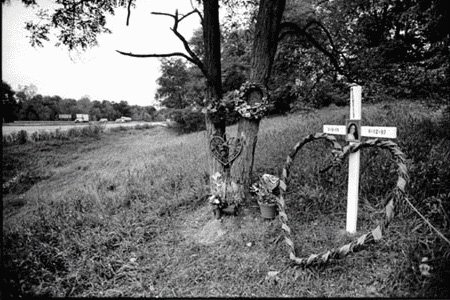
But those expecting Varanasises to start materializing alongside the Lincoln Highway or L.I.E. or the Dan Ryan Express or some other concrete Ganges meandering through the American landscape may have to temper their daydreams for a bit, as anything in the US that rests on some mercurial internal logic, such as memorializing our dearly departed, will invite twitchy, bureaucratic fingers to rein all of that in with central, regulatory control.
Take for instance Montana and California. While they don't object to memorials, they only allow them “if alcohol was a factor in the crash.” Wisconsin and New Jersey, meanwhile, “limit how long the memorials can remain in place.” And “Florida, Colorado and Texas will erect a nonreligious marker at the scene of a death. Missouri allows memorials but encourages victims' families to participate in the state's adopt-a-highway program instead.”
Also, “Delaware is taking a different approach, establishing a memorial park near a highway exit in hopes of discouraging the roadside shrines. The park will include a reflection pool and red bricks — provided free to the loved ones of highway accident victims — with names inscripted to honor the dead.”
Still, parts of the US are quite receptive: “Often called descansos, a Spanish word for 'resting places,' roadside memorials are most common in the American Southwest. Most researchers believe they descend from a Spanish tradition in which pallbearers left stones or crosses to mark where they rested as they carried a coffin by foot from the church to the cemetery. Because of this heritage, the memorials are protected in New Mexico as 'traditional cultural properties' by the state's Historic Preservation Division.”
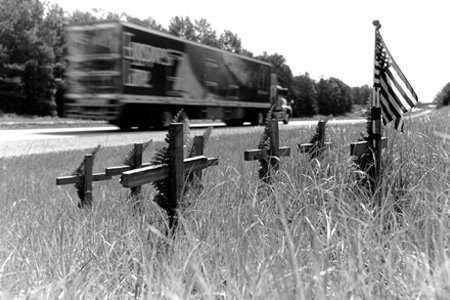
A few things:
1) It's only a matter of time (if not already) before roadside memorials become as iconic as the Land Survey grid, the gas station and the clover-leaf highway interchange — that is, a crucial part of the parageographic experience of the American landscape.
2) We should definitely reinstitute the ancient practice of siting cemeteries along traffic arteries: the celebration of death again a part of daily life. Besides the occasional shuttered malls, exuberant auto dealerships, and monolithic grain elevators, the ride up to Chicago from points southern can be intensely boring, even the political billboards and “Adult” signage have lost their amusement value after several passes.
But what if Interstate 57 looks decidedly Roman or Subcontinental — or imagine a hysterical combination of a Hindu cremation ritual, a New Orleans jazz funeral march, Jim Crace's quivering, and a High Baroque Requiem mass plus the nonstop visual, aromatic and aural assault from this thanatological mixture. The drive can be much livelier, in other words.
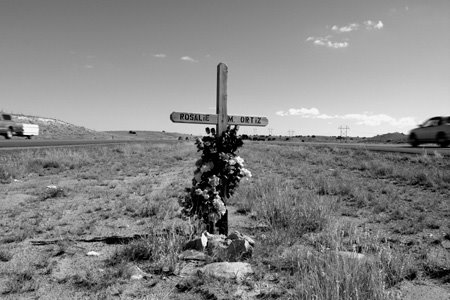
3) Why not a pyramid or a baker's tomb or statues in relief and in the round or an Eisenman or the winning entry in the Annual International Roadside Memorial Student Design Competition?
4) In a hundred years or in the next decade, pilgrimage routes crisscrossing the country will be very much well-established with all the varying roadside caravansaries stitched scenographically together — a tourist circuit populated by fans of vernacular America and by readers of Roadside(memorial)america.com.
Roadside America